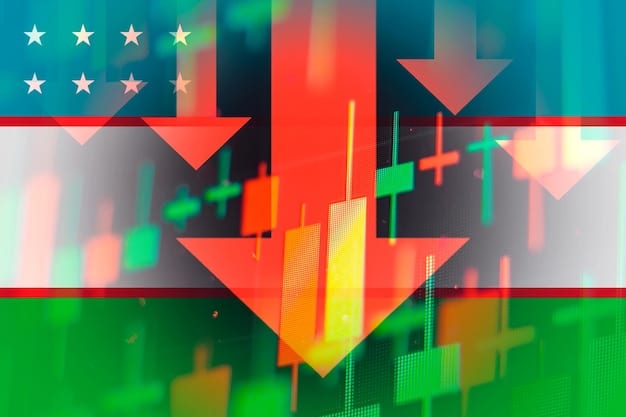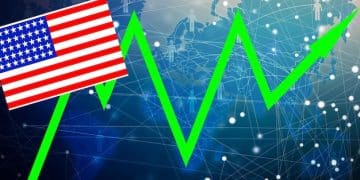Mexico’s 4.8% Inflation: US Consumer Goods Impact Explained

Mexico’s projected 4.8% inflation rate presents a complex economic scenario, potentially leading to increased costs for a broad range of US consumer goods due to intricate cross-border supply chains and shifting currency valuations, impacting everything from fresh produce to manufactured components.
Understanding Mexico’s inflation rate: How a projected 4.8% increase will affect US consumer goods prices is crucial for consumers and businesses alike. As the Mexican economy navigates its fiscal landscape, the ripple effects can extend far beyond its borders, directly influencing the prices Americans pay for everyday items.
Understanding the Mechanics of Mexican Inflation
Delving into the mechanics of Mexican inflation requires an understanding of its contributing factors and how it is measured. This foundational knowledge is essential before exploring its cross-border implications. Mexico’s inflation, like any nation’s, is influenced by a confluence of domestic and international forces.
At its core, inflation represents the rate at which the general level of prices for goods and services is rising, and, consequently, the purchasing power of currency is falling. In Mexico, this is typically measured by the Consumer Price Index (CPI) compiled by the National Institute of Statistics and Geography (INEGI). This index tracks price changes across a basket of goods and services that are representative of household consumption, including food, housing, transportation, and recreation.
Key Drivers of Inflation in Mexico
Several factors typically contribute to inflationary pressures in Mexico. These can range from internal policies to global economic shifts, each playing a role in the overall price environment.
- Fiscal Policy: Government spending and taxation policies can significantly influence aggregate demand. Expansionary fiscal policies, such as increased public spending, can boost demand beyond the economy’s capacity to supply, leading to price increases.
- Monetary Policy: The Bank of Mexico (Banxico) plays a critical role in managing inflation. Interest rate adjustments, reserve requirements, and open-market operations are tools used to control the money supply. An overly loose monetary policy can fuel inflation.
- Exchange Rate Fluctuations: Given Mexico’s open economy and strong trade ties, particularly with the US, the value of the Mexican peso relative to the US dollar is a significant factor. A depreciation of the peso makes imported goods more expensive, directly contributing to inflation.
- Global Commodity Prices: As an importer of various commodities, including some energy products and grains, global price spikes can transmit inflationary pressures into the Mexican economy.
- Supply Chain Disruptions: Recent global events have highlighted how disruptions in supply chains, from logistics bottlenecks to geopolitical conflicts, can limit the availability of goods and drive up prices.
Understanding these drivers is not just an academic exercise; it provides crucial context for the projected 4.8% increase. This specific projection suggests an assessment of these internal and external dynamics, indicating that some inflationary pressures are expected to persist or even intensify in the near future.
The interplay of these elements creates a complex economic environment. Banxico’s efforts to anchor inflation expectations while balancing economic growth often involve difficult trade-offs. The target inflation rate for Banxico is typically 3% +/- 1 percentage point, making a 4.8% projection a notable deviation that warrants close attention from both domestic and international observers. This deviation signals potential challenges in maintaining price stability within the country.
Decoding the 4.8% Inflation Projection: What It Signifies
A projected 4.8% inflation rate in Mexico carries specific implications that extend beyond a mere numerical increase. This figure suggests a persistent upward trend in prices, maintaining challenges for Mexican consumers and businesses, and critically, posing a ripple effect on its northern neighbor.
When economists project inflation, they are evaluating a multitude of indicators: consumer spending habits, energy prices, global supply chain stability, and the central bank’s stance on monetary policy. A 4.8% projection, particularly following periods of higher or lower inflation, indicates that while the most intense inflationary pressures might be easing from previous peaks, price growth remains above target and is not entirely under control.
Impact on Mexican Consumers and Production
For the average Mexican consumer, a 4.8% inflation rate means their purchasing power will erode. Basic necessities, such as food, transport, and utilities, will become incrementally more expensive. This forces households to adjust their budgets, prioritize spending, and often reduce discretionary purchases, which can dampen overall economic activity. Businesses, on the other hand, face increasing costs for raw materials, energy, and labor, squeezing profit margins and potentially leading to higher prices for their final products.
The concern isn’t just the absolute number, but the trend it represents. If inflation remains stubbornly elevated, it can lead to a wage-price spiral, where workers demand higher wages to compensate for rising costs, prompting businesses to raise prices further, creating a self-reinforcing cycle that is difficult to break. This instability can deter domestic investment and complicate long-term financial planning for both individuals and corporations within Mexico.
Moreover, the 4.8% figure indicates that Banxico will likely maintain a hawkish stance on monetary policy, keeping interest rates high to combat inflation. While this can help cool demand and reduce price pressures, it also makes borrowing more expensive for businesses and consumers, potentially slowing economic growth and investment. The delicate balance between controlling inflation and fostering growth is a constant challenge for monetary authorities.
The deviation from Banxico’s target range underscores the complexity of external shocks (like global commodity prices or geopolitical events) combined with internal economic conditions. This specific projection is not just a forecast; it’s a signal to markets and policymakers about entrenched price trends and the ongoing efforts required to restore stability. For US observers, it’s a critical early warning about potential shifts in cross-border economic dynamics, particularly regarding the availability and pricing of goods.

The Direct Link: Mexican Inflation and US Consumer Goods Pricess
The economic relationship between Mexico and the United States is deeply intertwined, especially through vast supply chains and extensive trade agreements. This interconnectedness means that inflation south of the border can have tangible effects on the prices of consumer goods available in US markets, often surprising those who might assume economic isolation.
One of the primary channels through which Mexican inflation impacts US consumer goods is via shared supply chains. Many products sold in the US contain components manufactured or assembled in Mexico. From automotive parts and electronics to textiles and processed foods, Mexican factories play a crucial role. When inflation increases in Mexico, the costs of production for these goods—including labor, raw materials, and energy—rise. Mexican manufacturers, facing higher operational expenses, are often compelled to pass these increased costs onto their US buyers, who then incorporate them into the final retail price for American consumers.
Key Product Categories Affected
The impact is not uniform across all sectors but is particularly pronounced in categories with significant Mexican production or agricultural imports.
- Fresh Produce: Mexico is a major supplier of fruits and vegetables to the US, especially during winter months. Higher production costs for Mexican farmers due to inflation (e.g., increased fertilizer prices, labor wages) translate directly into higher prices for avocados, tomatoes, berries, and other produce on US supermarket shelves.
- Automotive Parts & Vehicles: The North American automotive industry is highly integrated. Many vehicles assembled in the US contain parts manufactured in Mexico. Rising inflation in Mexico increases the cost of these components, contributing to higher prices for new cars and spare parts for US consumers.
- Manufactured Goods: A wide array of goods, from electronics and appliances to furniture and basic household items, involve Mexican manufacturing or assembly. Inflationary pressures in Mexico can push up the prices of these finished goods or their subcomponents, ultimately affecting their retail price in the US.
Beyond production costs, the interplay of currency exchange rates also plays a critical role. If the Mexican peso weakens significantly against the US dollar due to inflation or other economic instability, Mexican goods become cheaper for US buyers in dollar terms. However, if Mexican inflation outpaces this devaluation or if the peso strengthens, imported goods will become more expensive for US consumers. This dynamic is complex, as currency markets react to a multitude of factors, not just inflation.
Furthermore, disruptions in trade or elevated costs for cross-border logistics due to Mexican economic conditions (driven partly by inflation) can add to the overall price. Trucking costs, customs fees, and other logistical hurdles can all increase, contributing to the final price tag seen by the US consumer. The direct link is a consequence of deep economic integration and the practicalities of international trade, making Mexican inflation a relevant concern for the US consumer’s wallet.
Indirect Inflationary Pressures: Beyond the Border
While direct supply chain impacts are evident, Mexican inflation can also exert indirect inflationary pressures on US consumer goods. These less obvious mechanisms are often complex, involving shifts in investment, competitive landscapes, and broader economic sentiment, all of which can ultimately influence pricing and availability in the US market.
One significant indirect effect stems from investment decisions. High and persistent inflation in Mexico can deter foreign direct investment (FDI) into the country. If the cost of doing business in Mexico rises significantly, or if the economic outlook becomes uncertain, US companies might reconsider expanding or maintaining their operations there. This could lead to a reduction in certain goods being produced for the US market, potentially tightening supply and pushing up prices if demand remains constant or increases. Furthermore, it might force US companies to seek alternative, potentially more expensive, production locations.
Competition also plays a subtle role. If Mexican goods become more expensive due to domestic inflation, US retailers and consumers might turn to alternative suppliers either domestically or from other countries. This shift in demand itself doesn’t directly cause US inflation but can affect the competitive dynamics. For example, if a large volume of goods suddenly needs to be sourced from more distant or less efficient producers, the overall cost of supply for that product category could increase, eventually being reflected in retail prices.
Moreover, the interconnectedness of global financial markets means that economic instability in one major trading partner can create ripples. Significant inflation in Mexico could lead to concerns about broader emerging market stability, potentially influencing capital flows and exchange rates on a global scale. While less direct, such shifts can impact the borrowing costs for US businesses or the overall sentiment in financial markets, which can indirectly feed into business costs and consumer prices over time.
Finally, there’s the psychological element and expectations. While not directly inflationary, consistent news of rising costs in a major trading partner can contribute to an overall sense of inflationary pressure. Businesses may anticipate future cost increases and adjust their pricing strategies proactively, even before direct cost increases manifest. This “inflationary expectation” can become self-fulfilling to some extent, as companies and consumers brace for higher prices.
These indirect pathways highlight that the economic relationship is not merely transactional; it’s a dynamic system where shifts in one component can reverberate throughout the entire structure. Understanding these nuanced influences provides a more comprehensive view of how Mexico’s economic state, particularly its inflation rate, can subtly but powerfully shape the US consumer landscape.
Mitigating Strategies for US Businesses and Consumers
Facing the potential impact of Mexico’s rising inflation, both US businesses and consumers can adopt various strategies to mitigate adverse effects. These approaches aim to reduce exposure to increased costs and maintain financial stability amidst cross-border economic shifts.
For US Businesses
Businesses relying on Mexican imports or production facilities have several avenues to explore in order to protect their margins and maintain competitive pricing.
- Diversify Supply Chains: Reducing over-reliance on a single country for sourcing can spread risk. Businesses can explore alternative suppliers in other regions or even consider domestic production if feasible, thereby reducing vulnerability to Mexican inflation and currency fluctuations.
- Hedging Strategies: Financial instruments like currency forwards and options can be used to lock in exchange rates for future transactions, providing certainty against peso depreciation and making import costs more predictable, even as Mexican inflation rises.
- Long-term Contracts: Negotiating long-term supply contracts with Mexican partners, potentially with clauses for price adjustments tied to specific, agreed-upon economic indicators, can offer some stability and predictability in costs. Building strong relationships with suppliers can also facilitate more favorable terms.
- Efficiency Improvements: Investing in automation, process optimization, and logistical efficiencies within their Mexican operations or their supply chain management can help offset rising labor and material costs.
- Nearshoring/Reshoring Assessment: While a significant undertaking, evaluating the long-term benefits of bringing production closer to home or to other geographically stable regions could be a strategic move to insulate against future inflationary cycles in Mexico.
These strategies require careful consideration of cost, feasibility, and strategic alignment, but they offer concrete ways for businesses to navigate the complexities of international trade in an inflationary environment. Proactive planning is key to transforming potential challenges into managed risks.
For US Consumers
While consumers have less direct control over global supply chains, several personal finance strategies can help buffer the impact of rising prices on Mexican imports.
- Budgeting and Tracking Expenses: A clear understanding of where money is going can help identify areas for adjustment when prices rise. This includes monitoring the cost of frequently purchased goods that might be sourced from Mexico.
- Price Comparison and Brand Flexibility: Being willing to compare prices across different retailers and to consider alternative brands or private labels can help find better value. Sometimes, a slightly different brand or product from a different origin may offer a cost advantage.
- Seasonal Shopping: For produce, understanding peak seasons for domestic alternatives can lead to savings. While Mexican produce is vital in off-seasons for US crops, buying local when available can sometimes be more cost-effective.
- Bulk Buying (with caution): For non-perishable goods, purchasing in larger quantities when prices are stable or on sale can reduce the overall cost per unit, provided storage is adequate and consumption is guaranteed.
Empowering consumers with knowledge about how global economic trends affect their grocery bills and daily expenses allows them to make more informed purchasing decisions. Both businesses and consumers share the goal of navigating inflationary pressures with resilience and strategic adaptation.
Historical Precedents: Lessons from Past Inflationary Cycles
History offers valuable insights into how economies respond to, and recover from, inflationary pressures. Examining past inflationary cycles in Mexico and their impact on cross-border trade with the US can illuminate potential future scenarios and inform current strategies for understanding Mexico’s inflation rate: how a projected 4.8% increase will affect US consumer goods prices.
Mexico has experienced several periods of significant inflation throughout its modern economic history, particularly in the 1980s and early 1990s, where hyperinflation was a serious concern, and more recently, during global economic shocks. While the current 4.8% projection is far from hyperinflationary levels, the mechanisms that transmit price increases across borders remain largely consistent.
The Peso Crisis of 1994-1995
One of the most notable historical precedents is the Mexican peso crisis of 1994-1995, often referred to as the “Tequila Effect.” Although primarily a currency crisis, it led to a severe depreciation of the peso and a surge in Mexican inflation as imported goods became prohibitively expensive. For US businesses, this meant that while Mexican exports became cheaper in dollar terms, the internal instability and economic contraction in Mexico impacted demand for US goods and services, and the financial volatility created uncertainty for cross-border investments.
Lessons from this era include the importance of clear communication from central banks, the need for robust financial market regulation, and the inherent risks of deep economic integration without sufficient economic stability safeguards. It underscored how quickly domestic economic issues in a major trading partner can cascade internationally.
More recently, the inflationary spikes driven by post-pandemic supply chain disruptions and the war in Ukraine have demonstrated how global factors can exacerbate domestic price pressures in Mexico. During these periods, US consumers observed price increases in a range of goods, from fresh produce to manufactured components, reflective of the rising costs faced by Mexican producers.
Analyzing these cycles reveals a consistent pattern: the more integrated the economies, the more direct the transmission of inflationary pressures. For instance, in periods where Mexico faced higher energy costs, agricultural production became more expensive, directly contributing to higher food prices in the US. Similarly, when Mexican labor costs rose without corresponding productivity gains, the cost of manufactured goods produced for export inevitably increased.
These historical observations underscore that a projected 4.8% inflation rate, while moderate compared to past extremes, still warrants attention. It confirms that the flow of goods and capital between the two nations acts as a conduit for price changes. The lessons learned emphasize the need for adaptable supply chains for US businesses and for consumers to remain aware of global economic dynamics influencing their purchasing power. Understanding these historical precedents provides context for assessing the potential long-term implications of current inflationary trends in Mexico.
The Role of Banxico and US Federal Reserve Responses
The responses of central banks, specifically the Bank of Mexico (Banxico) and the US Federal Reserve (the Fed), are pivotal in shaping the economic landscape and influencing how Mexican inflation ripples through to US consumer goods prices. Their monetary policy decisions act as primary tools for managing inflation and maintaining economic stability in their respective economies.
Banxico’s Stance and Actions
Banxico operates under an inflation-targeting framework, aiming to keep inflation within a specific range, typically 3% +/- 1 percentage point. When faced with a projected 4.8% inflation rate, Banxico’s primary response is usually to tighten monetary policy, primarily by raising its benchmark interest rate. The rationale is to cool aggregate demand by making borrowing more expensive, which can help curb price increases.
- Interest Rate Hikes: Raising interest rates attempts to slow down economic activity, discouraging consumption and investment, thereby reducing inflationary pressures. This can also strengthen the peso, making imports cheaper in local currency terms, but also making Mexican exports more expensive.
- Communication: Banxico’s forward guidance and clear communication about its inflation outlook and policy intentions are crucial for anchoring inflation expectations among businesses and consumers.
- Monitoring External Factors: Given Mexico’s open economy, Banxico carefully monitors global commodity prices, international interest rates, and trade dynamics, as these external factors can significantly influence domestic inflation.
The challenge for Banxico is often to balance inflation control with supporting economic growth. Aggressive rate hikes, while effective against inflation, can risk slowing down the economy too much, leading to job losses and reduced investment. Their response directly influences the cost of doing business in Mexico, which then feeds into export prices for the US market.
The US Federal Reserve’s Influence
The US Federal Reserve’s monetary policy, while focused on domestic US inflation and employment, can also indirectly influence the impact of Mexican inflation on US consumer goods. The Fed’s actions affect the value of the US dollar, global capital flows, and demand within the US economy.
- Dollar Strength: If the Fed aggressively raises interest rates, it can strengthen the US dollar relative to other currencies, including the Mexican peso. A stronger dollar makes Mexican imports cheaper for US buyers, potentially offsetting some of the inflationary pressures from Mexico. Conversely, a weaker dollar makes imports more expensive.
- US Demand: The Fed’s efforts to control US inflation by slowing down the US economy can reduce overall consumer demand. This might lead US retailers and importers to be less willing to absorb higher prices from Mexican suppliers, potentially forcing Mexican producers to absorb some of the inflation or seek efficiencies.
- Global Liquidity: The Fed’s policy also affects global liquidity and risk appetite. When the Fed tightens, capital can flow back to the US, potentially putting pressure on emerging market currencies like the peso, which can have complex effects on trade prices.
The combined actions of Banxico and the Fed create a dynamic interplay. Banxico’s efforts to control domestic inflation directly impact the cost structure of Mexican goods. The Fed’s policies, through currency effects and overall US economic demand, then determine how those costs are absorbed or passed on to the US consumer. Understanding this sophisticated interplay is essential for a comprehensive view of cross-border price dynamics.
Future Outlook and Long-Term Implications for US Consumers
The future outlook regarding Mexico’s inflation rate and its long-term implications for US consumers is multifaceted, dependent on a confluence of domestic Mexican policies, global economic trends, and the ongoing evolution of supply chains. A projected 4.8% inflation rate for Mexico, while a mid-term forecast, suggests persistent vigilance is required.
In the long term, the trajectory of Mexican inflation will hinge significantly on the effectiveness of Banxico’s monetary policy in anchoring inflation expectations and addressing structural economic issues. Should Banxico succeed in bringing inflation back closer to its target range, the cost pressures on Mexican exports to the US would likely ease. Conversely, if inflationary pressures prove more stubborn due to persistent supply-side shocks or significant fiscal expansion, US consumers could continue to face elevated prices for imported Mexican goods.
Potential Scenarios and Their Effects
Considering different scenarios can help elucidate potential long-term implications:
- Scenario 1: Inflationary Persistence. If Mexican inflation remains elevated (e.g., above 4% consistently), US businesses may accelerate efforts to diversify supply chains away from Mexico or invest heavily in automation within Mexican facilities to offset labor cost increases. This could lead to a fundamental restructuring of North American supply chains, potentially affecting the availability and variety of certain Mexican products in the US or leading to higher retail prices as sourcing becomes more complex or expensive.
- Scenario 2: Inflationary Containment. Should Banxico successfully bring inflation down to its target, and the Mexican economy stabilizes, the direct inflationary pressure on US consumer goods would diminish. This could foster continued strong trade relations and potentially stabilize or even reduce prices for Mexican imports in the US, depending on other cost factors.
- Scenario 3: Global Economic Shifts. Broader global economic trends, such as oil prices, geopolitical stability, and the strength of the US dollar, will always play a significant role. For instance, a strong dollar can naturally offset some Mexican inflationary pressures by making Mexican goods cheaper in dollar terms, irrespective of their local currency cost.
From a consumer perspective, the long-term implications point towards increasing interconnectedness. Americans may need to become more accustomed to the idea that their shopping habits and household budgets are indirectly influenced by economic conditions in major trading partners like Mexico. This could mean a continued emphasis on price transparency, brand flexibility, and awareness of the origins of goods. The ‘Mexico effect’ on US consumer goods will likely evolve with the broader global economic landscape.
Ultimately, a projected 4.8% Mexican inflation rate is not an isolated event but a signal within a complex global economic system. For US consumers, it translates into a continued need for adaptability, informed purchasing decisions, and an understanding that the price labels on their shelves are often the culmination of intricate international economic forces. The long-term trajectory will depend on how effectively both nations navigate their economic challenges and capitalize on their symbiotic trade relationship.
| Key Point | Brief Description |
|---|---|
| 📊 Inflation Basics | Mexico’s 4.8% projected inflation means rising general prices; measured by CPI. |
| 🛒 US Consumer Impact | Directly affects prices of Mexican imports like produce, auto parts, and manufactured goods due to increased production costs. |
| 🔄 Supply Chain Ripples | Indirectly influences US costs through investment shifts, competitive dynamics, and logistical expenses. |
| 🏦 Central Bank Role | Banxico’s rate hikes and the Fed’s dollar strength influences combine to shape cross-border price effects. |
Frequently Asked Questions
▼
In Mexico’s economy, inflation refers to the general increase in prices for goods and services over time, leading to a decrease in the purchasing power of the Mexican peso. It’s measured by the Consumer Price Index (CPI), reflecting how daily necessities become more expensive for the average household.
▼
A 4.8% Mexican inflation rate directly impacts US consumers by increasing the cost of goods imported from Mexico. This includes fresh produce, automotive parts, and various manufactured items, as Mexican producers face higher operational costs and pass them onto US importers and, subsequently, consumers.
▼
While many goods can be affected, the impact is most pronounced in sectors with significant Mexican import dependency. This primarily includes agricultural products like fruits and vegetables, and industries with integrated supply chains like the automotive sector. Other manufactured goods with components sourced from Mexico are also susceptible.
▼
Indirect influences include shifts in foreign direct investment, as businesses might hesitate to invest in Mexico due to instability, affecting supply. It can also alter competitive dynamics, as US buyers seek alternatives, potentially leading to higher costs. Additionally, overall economic sentiment and currency fluctuations contribute indirectly.
▼
US consumers can mitigate impacts by practicing diligent budgeting, comparing prices across brands and retailers, and being flexible with product choices. Exploring seasonal domestic produce, when available, and considering bulk purchases for non-perishable goods can also help manage rising costs from imports.
Conclusion
The projected 4.8% increase in Mexico’s inflation rate is a significant economic indicator with clear implications for US consumer goods prices. As demonstrated, the intricate web of cross-border trade, shared supply chains, and dynamic economic policies ensures that economic shifts in one nation inevitably reverberate in the other. Understanding these connections allows US consumers and businesses to anticipate potential price adjustments, strategize for mitigation, and adapt to the evolving landscape of international commerce. The continuous interplay between central bank actions, global commodity prices, and consumer demand will ultimately shape the long-term impact, underscoring the importance of informed economic awareness in an increasingly interconnected world.





